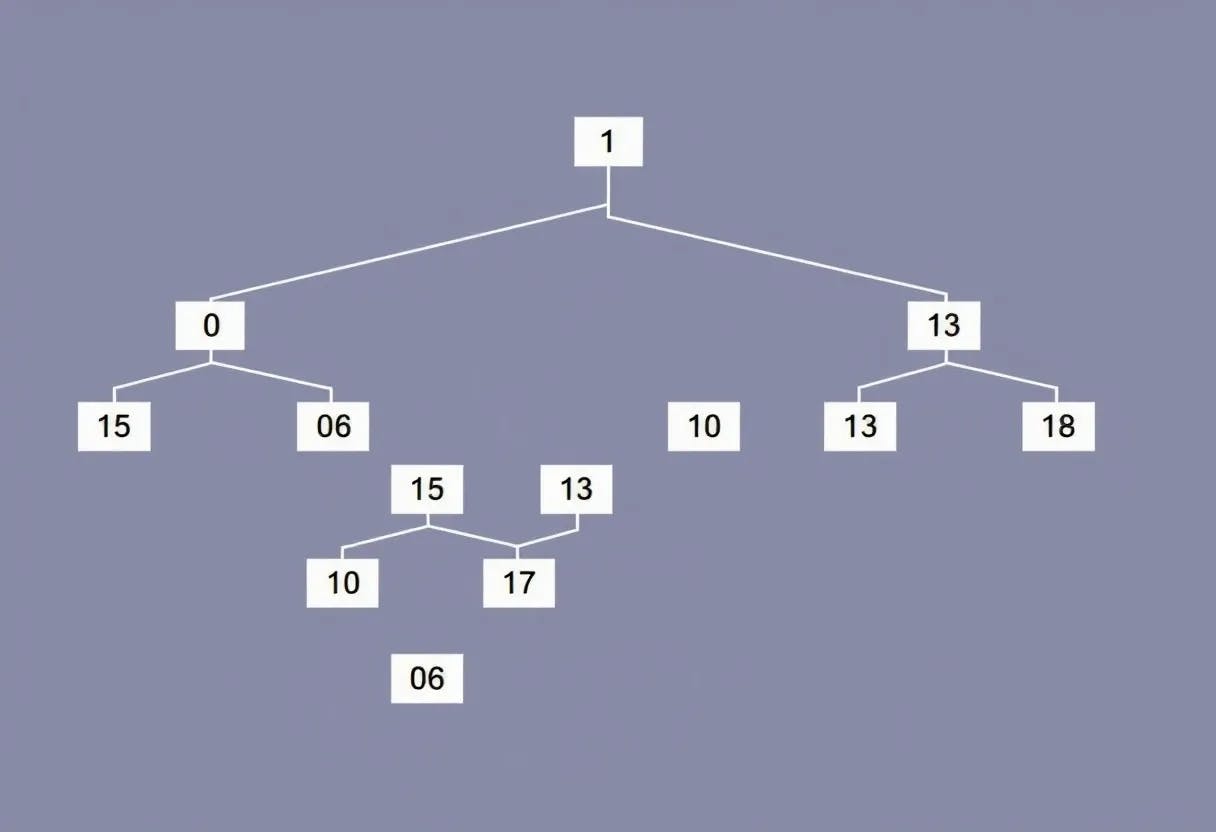Authors:
(1) Oleksandr Kuznetsov, Proxima Labs, 1501 Larkin Street, suite 300, San Francisco, USA and Department of Political Sciences, Communication and International Relations, University of Macerata, Via Crescimbeni, 30/32, 62100 Macerata, Italy ([email protected]);
(2) Dzianis Kanonik, Proxima Labs, 1501 Larkin Street, suite 300, San Francisco, USA;
(3) Alex Rusnak, Proxima Labs, 1501 Larkin Street, suite 300, San Francisco, USA ([email protected]);
(4) Anton Yezhov, Proxima Labs, 1501 Larkin Street, suite 300, San Francisco, USA;
(5) Oleksandr Domin, Proxima Labs, 1501 Larkin Street, suite 300, San Francisco, USA.
Table of Links
1.1. The Blockchain Paradigm and the Challenge of Scalability
1.3. Our contribution and 1.4. Article structure
2. Conceptualizing the Problem
3. Our Idea for Optimizing Trees in Blockchain
4. Efficiency of adaptive Merkle trees
5. Algorithm for Merkle Tree Restructuring
6.2. Example 1.1: Binary Tree Restructuring Through Leaf Node Swapping
6.3. Example 2.1: Restructuring a Non-Binary Tree by Adding a Single Leaf
6.4. Example 2.2: Restructuring a Non-Binary Tree Through Leaf Pair Swapping
6.5. Example 2.3: Restructuring a Patricia-Merkle Tree Fragment Through Leaf Pair Swapping
7. Path Encoding in the Adaptive Merkle Tree
8.2. Technology and Advantages
9.2. Comparison with Existing Solutions
10. Conclusion
The exploration of adaptive restructuring in Merkle and Verkle trees within this study presents a novel approach to addressing the enduring challenge of blockchain scalability. By dynamically adjusting the structure of these trees based on usage patterns, we propose a method that significantly reduces the average path length for verification processes, thereby enhancing the efficiency and scalability of blockchain systems.
Our contribution to the field of blockchain technology is twofold. Firstly, we introduce a conceptual framework for the adaptive restructuring of Merkle trees, which lays the groundwork for practical implementations in existing blockchain infrastructures. Secondly, through a series of detailed examples, we demonstrate the feasibility and benefits of our approach, highlighting its potential to optimize verification processes and reduce associated costs.
Comparative analysis with existing scalability solutions reveals that while many approaches offer improvements in transaction throughput and efficiency, they often introduce additional complexity or security concerns. In contrast, adaptive restructuring directly targets the underlying data structure of the blockchain, offering foundational improvements without compromising on security or introducing external dependencies.
The implications of our research extend beyond theoretical advancements. By providing a scalable and efficient method for data verification, adaptive restructuring has the potential to facilitate broader adoption of blockchain technology across various sectors, including finance, supply chain management, and beyond. It opens up new avenues for blockchain applications that require high throughput and efficient data integrity verification.
In conclusion, the adaptive restructuring of Merkle and Verkle trees represents a significant step forward in the quest for blockchain scalability. It offers a unique blend of efficiency, security, and practicality, making it a promising solution for the next generation of blockchain systems. As the blockchain ecosystem continues to evolve, the principles and methodologies outlined in this study will undoubtedly contribute to its growth and maturity, paving the way for more scalable, efficient, and versatile blockchain architectures.
References
[1] Xu K, Zhu J, Song X, Lu Z, editors. Blockchain Technology and Application: Third CCF China Blockchain Conference, CBCC 2020, Jinan, China, December 18-20, 2020, Revised Selected Papers. vol. 1305. Singapore: Springer; 2021. https://doi.org/10.1007/978-981-33- 6478-3.
[2] Lee S-W, Singh I, Mohammadian M, editors. Blockchain Technology for IoT Applications. Singapore: Springer; 2021. https://doi.org/10.1007/978-981-33-4122-7.
[3] Krichen M, Ammi M, Mihoub A, Almutiq M. Blockchain for Modern Applications: A Survey. Sensors 2022;22:5274. https://doi.org/10.3390/s22145274.
[4] IEEE Draft Standard for Blockchain-based Digital Asset Classification. IEEE P3206/D10, April 2023 2023:1–20.
[5] Zeba S, Suman P, Tyagi K. Chapter 4 - Types of blockchain. In: Pandey R, Goundar S, Fatima S, editors. Distributed Computing to Blockchain, Academic Press; 2023, p. 55–68. https://doi.org/10.1016/B978-0-323-96146-2.00003-6.
[6] Tiwari A. Chapter 14 - Cryptography in blockchain. In: Pandey R, Goundar S, Fatima S, editors. Distributed Computing to Blockchain, Academic Press; 2023, p. 251–65. https://doi.org/10.1016/B978-0-323-96146-2.00011-5.
[7] Ethereum Cumulative Unique Addresses n.d. https://ycharts.com/indicators/ethereum_cumulative_unique_addresses (accessed January 11, 2024).
[8] Ethereum Daily Active Addresses n.d. https://ycharts.com/indicators/ethereum_daily_active_addresses (accessed January 11, 2024).
[9] Kottursamy K, Sadayapillai B, AlZubi AA, Bashir AK. A novel blockchain architecture with mutable block and immutable transactions for enhanced scalability. Sustainable Energy Technologies and Assessments 2023;58:103320. https://doi.org/10.1016/j.seta.2023.103320.
[10] Li Y, Weng J, Wu W, Li M, Li Y, Tu H, et al. PRI: PCH-based privacy-preserving with reusability and interoperability for enhancing blockchain scalability. Journal of Parallel and Distributed Computing 2023;180:104721. https://doi.org/10.1016/j.jpdc.2023.104721.
[11] Nasir MH, Arshad J, Khan MM, Fatima M, Salah K, Jayaraman R. Scalable blockchains — A systematic review. Future Generation Computer Systems 2022;126:136–62. https://doi.org/10.1016/j.future.2021.07.035.
[12] Sanka AI, Cheung RCC. A systematic review of blockchain scalability: Issues, solutions, analysis and future research. Journal of Network and Computer Applications 2021;195:103232. https://doi.org/10.1016/j.jnca.2021.103232.
[13] Sharma A, Pilli ES, Mazumdar AP, Jain A. BLAST-IoT: BLockchain Assisted Scalable Trust in Internet of Things. Computers and Electrical Engineering 2023;109:108752. https://doi.org/10.1016/j.compeleceng.2023.108752.
[14] Wang M, Wu Q. Fast intensive validation on blockchain with scale-out dispute resolution. Computer Standards & Interfaces 2024;89:103820. https://doi.org/10.1016/j.csi.2023.103820.
[15] Wang Y, Li Y, Suo Y, Qiang Y, Zhao J, Li K. A scalable, efficient, and secured consensus mechanism for Vehicle-to-Vehicle energy trading blockchain. Energy Reports 2023;10:1565–74. https://doi.org/10.1016/j.egyr.2023.07.035.
[16] Xiao J, Luo T, Li C, Zhou J, Li Z. CE-PBFT: A high availability consensus algorithm for large-scale consortium blockchain. Journal of King Saud University - Computer and Information Sciences 2024;36:101957. https://doi.org/10.1016/j.jksuci.2024.101957.
[17] Yu B, Zhao H, Zhou T, Sheng N, Li X, Xu J. OverShard: Scaling blockchain by full sharding with overlapping network and virtual accounts. Journal of Network and Computer Applications 2023;220:103748. https://doi.org/10.1016/j.jnca.2023.103748.
[18] Zhen Z, Wang X, Lin H, Garg S, Kumar P, Hossain MS. A dynamic state sharding blockchain architecture for scalable and secure crowdsourcing systems. Journal of Network and Computer Applications 2024;222:103785. https://doi.org/10.1016/j.jnca.2023.103785.
[19] Ayyalasomayajula P, Ramkumar M. Optimization of Merkle Tree Structures: A Focus on Subtree Implementation. 2023 International Conference on Cyber-Enabled Distributed Computing and Knowledge Discovery (CyberC), 2023, p. 59–67. https://doi.org/10.1109/CyberC58899.2023.00021.
[20] Jeon K, Lee J, Kim B, Kim JJ. Hardware Accelerated Reusable Merkle Tree Generation for Bitcoin Blockchain Headers. IEEE Computer Architecture Letters 2023;22:69–72. https://doi.org/10.1109/LCA.2023.3289515.
[21] Jing S, Zheng X, Chen Z. Review and Investigation of Merkle Tree’s Technical Principles and Related Application Fields. 2021 International Conference on Artificial Intelligence, Big Data and Algorithms (CAIBDA), 2021, p. 86–90. https://doi.org/10.1109/CAIBDA53561.2021.00026.
[22] Knollmann T, Scheideler C. A self-stabilizing Hashed Patricia Trie. Information and Computation 2022;285:104697. https://doi.org/10.1016/j.ic.2021.104697.
[23] Lin K-W, Chen Y-C. A File Verification Scheme Based on Verkle Trees. 2023 International Conference on Consumer Electronics - Taiwan (ICCE-Taiwan), 2023, p. 295–6. https://doi.org/10.1109/ICCE-Taiwan58799.2023.10226788.
[24] Liu H, Luo X, Liu H, Xia X. Merkle Tree: A Fundamental Component of Blockchains. 2021 International Conference on Electronic Information Engineering and Computer Science (EIECS), 2021, p. 556–61. https://doi.org/10.1109/EIECS53707.2021.9588047.
[25] Mardiansyah V, Muis A, Sari RF. Multi-State Merkle Patricia Trie (MSMPT): HighPerformance Data Structures for Multi-Query Processing Based on Lightweight Blockchain. IEEE Access 2023;11:117282–96. https://doi.org/10.1109/ACCESS.2023.3325748.
[26] Mitra D, Tauz L, Dolecek L. Graph Coded Merkle Tree: Mitigating Data Availability Attacks in Blockchain Systems Using Informed Design of Polar Factor Graphs. IEEE Journal on Selected Areas in Information Theory 2023;4:434–52. https://doi.org/10.1109/JSAIT.2023.3315148.
[27] Zhao X, Zhang G, Long H-W, Si Y-W. Minimizing block incentive volatility through Verkle tree-based dynamic transaction storage. Decision Support Systems 2024;180:114180. https://doi.org/10.1016/j.dss.2024.114180.
This paper is available on arxiv under CC by 4.0 Deed (Attribution 4.0 International) license.

